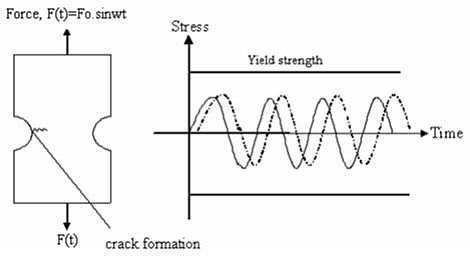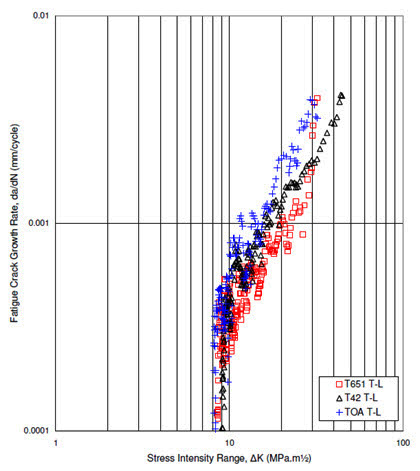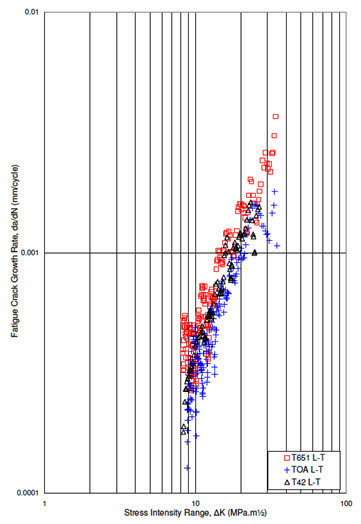Fatigue Properties of Aluminum Alloys in Aerospace Applications
Abstract
The aerospace industry's continuous pursuit of lightweight, high-performance materials has intensified research into aluminum alloy fatigue properties. This study examines the critical role of fatigue testing in ensuring material suitability for aerospace applications before expensive design processes commence. Research on AA6013 aluminum alloy demonstrates how different aging treatments significantly influence fatigue crack growth behavior. Testing revealed that T651 peak-aged condition provides superior fatigue crack growth resistance in T-L orientation, while over-aged TOA condition performs best in L-T orientation. Understanding these fatigue characteristics is essential for optimizing aluminum alloy performance in aircraft structures, where approximately 80% of airframe weight consists of aluminum components. These findings support lifecycle-based material selection strategies that balance performance requirements with cost considerations in modern aviation.
Introduction to Aluminum Alloys in Aerospace Engineering
The continuous evolution of military and civilian aircraft structures has led to significant improvements in aircraft performance capabilities. However, design advancements in newly developed aircraft structures remain constrained by the properties of currently available materials. This limitation creates a well-defined need to understand and enhance the properties of materials presently utilized in the aerospace industry.
Aluminum and its alloys have achieved widespread success across diverse applications, ranging from packaging industries to aerospace engineering. These materials possess superior mechanical properties combined with low density characteristics, providing significant advantages over conventional structural materials. Aluminum alloys continue to dominate as the primary structural materials for aircraft construction, with most aircraft airframes consisting of approximately 80% aluminum by weight.
Economic Considerations in Aluminum Alloy Selection
Cost reduction strategies have become increasingly important criteria for airlines worldwide, leading to material selection processes based on comprehensive lifecycle approaches. While composite materials present competitive alternatives for aircraft structural applications, they typically involve higher initial costs, require more intensive manual labor during production, and incur greater maintenance expenses compared to aluminum alloys.
The economic advantage of aluminum alloys extends beyond initial material costs to encompass manufacturing efficiency, maintenance requirements, and long-term durability. These factors contribute to the continued preference for aluminum alloys in aerospace applications, despite ongoing developments in alternative materials.
Understanding Fatigue Mechanisms in Aluminum Alloys
Fatigue represents the most critical failure mode requiring consideration in mechanical design applications. The physical process of fatigue involves a complex sequence of events that can lead to catastrophic failure if not properly understood and controlled.

Figure 1: Illustration of the fundamental fatigue mechanism
Under the influence of oscillatory tensile stresses of sufficient magnitude, small cracks initiate at stress concentration points within the material structure. Once crack initiation occurs, the crack propagates in a direction orthogonal to the oscillatory tensile loading direction. This progressive crack growth continues until the remaining material cross-section can no longer support the applied loads, resulting in sudden failure.
Fatigue failures present particularly dangerous scenarios because they occur without warning signs and may cause significant property damage and loss of life. The catastrophic nature of fatigue failures emphasizes the critical importance of comprehensive fatigue testing and analysis during the design phase.
Fatigue Damage Mechanisms and Loading Characteristics
Fatigue damage correlates directly with cycle amplitudes and ranges rather than peak stress values. This relationship means that statistical properties such as stress amplitudes and mean values determine fatigue damage accumulation under various loading conditions. Understanding these relationships enables engineers to predict fatigue life more accurately and design components with appropriate safety margins.
The goal of implementing advanced fatigue analysis techniques in the design process involves performing fatigue and durability calculations during early design stages. This approach reduces or eliminates the need for expensive redesign efforts later in the development process, ultimately improving both cost effectiveness and safety margins.
Experimental Investigation of AA6013 Aluminum Alloy Fatigue Properties
Recent research by Varly E.A. and colleagues investigated the effects of different aging treatments on fatigue crack growth behavior in AA6013 aluminum alloy. This comprehensive study utilized Compact Tension (C(T)) specimens prepared in both L-T and T-L orientations to evaluate fatigue performance under controlled conditions.
Heat Treatment Conditions and Testing Parameters
The experimental program examined three distinct aging conditions to determine their influence on fatigue crack growth resistance:
- T651 Peak-Aged Condition: Specimens were tested in the as-received condition, representing the standard peak-aged temper commonly used in aerospace applications.
- T42 Natural-Aged Condition: Specimens underwent solution heat treatment at 538°C for 90 minutes, followed by water quenching and natural aging at room temperature for 96 hours.
- Over-Aged Condition (TOA): Specimens received T42 temper treatment followed by over-aging at 245°C for 12 hours, creating a unique microstructural condition for comparison.
Electrical conductivity and hardness measurements were performed to verify the effectiveness of heat treatment processes and ensure consistent material properties across test specimens. Fatigue crack growth testing was conducted using a stress ratio of R = 0.1 and a frequency of 4 Hz, providing standardized conditions for comparative analysis.
Fatigue Crack Growth Rate Analysis
The experimental results generated comprehensive fatigue crack growth rate diagrams (da/dN vs ΔK) for all three aging conditions in both specimen orientations. These diagrams provide critical insights into the relationship between stress intensity factor range and crack growth rate for different heat treatment conditions.

Figure 2: da/dN vs. ΔK plots of three ageing conditions in T-L direction

Figure 3: da/dN vs. ΔK plots of three ageing conditions in L-T direction
T-L Orientation Performance Results
In the T-L orientation testing, the T651 peak-aged condition demonstrated the highest fatigue crack growth resistance compared to both naturally aged T42 and over-aged TOA conditions. This superior performance indicates that the standard peak-aging treatment optimizes the microstructural characteristics for fatigue resistance in this specific loading orientation.
The enhanced fatigue performance of T651 condition in T-L orientation can be attributed to the optimal precipitation state achieved during peak aging. This microstructural condition provides the ideal balance between strength and toughness required for superior fatigue crack growth resistance.
L-T Orientation Performance Results
Conversely, in the L-T orientation, the over-aged TOA condition exhibited superior fatigue performance compared to both T42 naturally aged and T651 peak-aged conditions. This result demonstrates the significant influence of specimen orientation on fatigue behavior and highlights the importance of considering directional properties in aerospace applications.
The superior performance of the over-aged condition in L-T orientation suggests that the coarser precipitation structure developed during over-aging provides beneficial characteristics for fatigue crack growth resistance in this specific orientation. Over-aging improved fatigue life across all stress intensity factor range (ΔK) levels tested.
Engineering Implications and Design Considerations
The research findings reveal important implications for aerospace engineering applications where aluminum alloys experience complex loading conditions. The orientation-dependent fatigue behavior demonstrates that material selection and heat treatment optimization must consider the specific loading directions expected in service.
For components primarily loaded in the T-L direction, the standard T651 peak-aged condition provides optimal fatigue performance. However, for applications involving L-T loading orientations, over-aging treatments may offer superior fatigue resistance despite potential reductions in other mechanical properties.
Microstructural Considerations in Fatigue Performance
The observed differences in fatigue crack growth resistance between aging conditions reflect underlying microstructural variations created by different heat treatment processes. Peak aging develops fine, coherent precipitates that provide optimal strength, while over-aging produces coarser, less coherent precipitates that may offer different advantages for fatigue crack growth resistance.
The relationship between microstructure and fatigue performance highlights the importance of understanding precipitation kinetics and their influence on crack initiation and propagation mechanisms. This knowledge enables optimization of heat treatment processes for specific applications and loading conditions.
Future Research Directions and Applications
The research findings establish a foundation for continued investigation into aluminum alloy fatigue properties and their optimization for aerospace applications. Future studies should examine additional aging conditions, loading orientations, and environmental factors to develop comprehensive design guidelines for aluminum alloy components.
Advanced characterization techniques, including electron microscopy and in-situ testing methods, could provide deeper insights into the microstructural mechanisms responsible for orientation-dependent fatigue behavior. This understanding would enable development of more sophisticated predictive models for fatigue life estimation.
Conclusion
The investigation of AA6013 aluminum alloy fatigue properties demonstrates the critical importance of considering both heat treatment conditions and loading orientations in aerospace applications. The research reveals that T651 peak-aged condition provides superior fatigue crack growth resistance in T-L orientation, while over-aged TOA condition performs best in L-T orientation.
These findings support the development of orientation-specific heat treatment strategies that optimize fatigue performance for particular applications. The continued dominance of aluminum alloys in aerospace structures, comprising approximately 80% of airframe weight, emphasizes the importance of understanding and optimizing these fatigue characteristics.
The economic advantages of aluminum alloys, combined with their superior fatigue performance when properly optimized, ensure their continued importance in aerospace applications. Future developments in heat treatment optimization and microstructural control will further enhance the performance capabilities of aluminum alloys in demanding aerospace environments.
Understanding fatigue properties through comprehensive testing and analysis remains absolutely essential for ensuring material suitability before progressing through expensive design processes and product realization phases. This research contributes valuable insights for engineers designing next-generation aircraft structures with improved performance and reliability characteristics.
Uzyskaj dostęp do cyklicznych właściwości tysięcy materiałów już teraz!
Total Materia Horizon zawiera unikalną kolekcję właściwości zmęczeniowych materiałów metalowych i niemetalowych, zarówno dla zmęczenia niskocyklicznego, jak i wysokocyklicznego.

Uzyskaj BEZPŁATNE konto testowe w Total Materia Horizon i dołącz do społeczności ponad 500 000 użytkowników z ponad 120 krajów.